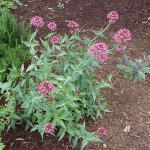| Drug Interactions: |
| Taking valerian with these drugs may cause or increase serotonin syndrome (symptoms of which include agitation, rapid heart rate, flushing, heavy sweating, and possibly even death): |
| Desipramide, (Alti-Desipramine, Norpramin) |
Doxepin, (Sinequan, Zonalon) |
Fluvoxamine, (Alti-Fluvoxamine, Luvox) |
Imipramine, (Apo-Imipramine, Tofranil) |
Nefazodone, (Serzone) |
| Nortriptyline, (Aventyl HCl, Pamelor) |
Pramipexole, (Mirapex) |
Protriptyline, (Vivactil) |
Trazodone, (Desyrel, Novo-Trazodone) |
Venlafaxine, (Effexor) |
| Taking valerian with these drugs may increase the risk of bleeding or bruising: |
| Abciximab, (ReoPro) |
Alteplase, (Activase, Cathflo Activase) |
Antithrombin III, (Thrombate III) |
Argatroban, (Argatroban) |
| Aspirin, (Bufferin, Ecotrin) |
Aspirin and Dipyridamole, (Aggrenox) |
Bivalirudin, (Angiomax) |
Clopidogrel, (Plavix) |
| Dalteparin, (Fragmin) |
Danaparoid, (Orgaran) |
Dipyridamole, (Novo-Dipiradol, Persantine) |
Enoxaparin, (Lovenox) |
| Eptifibatide, (Integrillin) |
Fondaparinux, (Arixtra) |
Heparin, (Hepalean, Hep-Lock) |
Indobufen, (Ibustrin) |
| Lepirudin, (Refludan) |
Nadroparin, (Fraxiparine) |
Reteplase, (Retavase) |
Streptokinase, (Streptase) |
| Tenecteplase, (TNKase) |
Ticlopidine, (Alti-Ticlipodine, Ticlid) |
Tinzaparin, (Innohep) |
Tirofiban, (Aggrastat) |
| Urokinase, (Abbokinase) |
Warfarin, (Coumadin, Jantoven) |
| Taking valerian with these drugs may reduce or prevent drug absorption: |
| Ferric gluconate, (Ferrlecit) |
Ferrous Fumarate, (Femiron, Feostat) |
Ferrous Gluconate, (Fergon, Novo-Ferrogluc) |
Ferrous Sulfate, (Feratab, Fer-Iron) |
| Ferrous Sulfate and Ascorbic Acid, (Fero-Grad 500, Vitelle Irospan) |
Iron-Dextran Complex, (Dexferrum, INFeD) |
Polysaccharide-Iron Complex, (Hytinic, Niferex) |
| Taking valerian with these drugs may hinder the therapeutic effects of the drug: |
| Iproniazid, (Marsilid) |
Moclobemide, (Alti-Moclobemide, Nu-Moclobemide) |
Phenelzine, (Nardil) |
Phenytoin, (Dilantin, Phenytek) |
| Selegiline, (Eldepryl) |
Tranylcypromine, (Parnate) |
Warfarin, (Coumadin, Jantoven) |
| Taking valerian with these drugs may increase the risk of excessive sedation and mental depression and impairment: |
| Acetaminophen and Codeine, (Capital and Codeine, Tylenol with Codeine) |
Alfentanil, (Alfenta) |
Alprazolam, (Apo-Alpraz, Xanax) |
Allopurinol, (Aloprim, Zyloprim) |
Amitriptyline, (Elavil, Levate) |
Amobarbital, (Amytal) |
Amobarbital and Secobarbital, (Tuinal) |
| Amoxapine, (Asendin) |
Aripiprazole, (Abilify) |
Aspirin and Codeine, (Coryphen Codeine) |
Baclofen, (Lioresal, Nu-Baclo) |
Belladonna and Opium, (B&O Supprettes) |
Bromazepam, (Apo-Bromazepam, Gen-Bromazepam) |
Brotizolam, (Lendorm, Sintonal) |
| Buprenorphine, (Buprenex, Subutex) |
Buprenorphine and Naloxone, (Suboxone) |
Bupropion, (Wellbutrin, Zyban) |
Butabarbital, (Butisol Sodium) |
Butalbital, Acetaminophen, and Caffeine, (Esgic, Fioricet) |
Butalbital, Aspirin and Caffeine, (Fiorinal) |
Butorphanol, (Apo-Butorphanol, Stadol) |
| Carbamazepine, (Carbatrol, Tegretol) |
Chloral Hydrate, (Aquachloral Supprettes, Somnote) |
Chlordiazepoxide, (Apo-Chlordiazepoxide, Librium) |
Chlorpromazine, (Thorazine) |
Citalopram, (Celexa) |
Clobazam, (Alti-Clobazam, Frisium) |
Clomipramine, (Anafranil, Novo-Clopramine) |
| Clonazepam, (Klonopin, Rivotril) |
Clonidine, (Catapres, Duraclon) |
Clorazepate, (Tranxene, T-Tab) |
Clozapine, (Clozaril, Gen-Clozapine) |
Codeine, (Codeine Contin) |
Cyclobenzaprine, (Flexeril, Novo-Cycloprine) |
Dantrolene, (Dantrium) |
| Desipramine, (Alti-Desipramine, Norpramin) |
Dexmedetomidine, (Precedex) |
Diazepam, (Apo-Diazepam, Valium) |
Dihydrocodeine, Aspirin, and Caffeine, (Synalgos-DC) |
Diphenhydramine, (Benadryl Allergy, Nytol) |
Doxepin, (Sinequan, Zonalon) |
Doxylamine and Pyridoxine, (Diclectin) |
| Estazolam, (ProSom) |
Fentanyl, (Actiq, Duragesic) |
Fexofenadine, (Allegra) |
Fluoxetine, (Prozac, Sarafem) |
Fluphenazine, (Prolixin, Modecate) |
Flurazepam, (Apo-Flurazepam, Dalmane) |
Fluvoxamine, (Alti-Fluvoxamine, Luvox) |
| Gabapentin, (Neurontin, Nu-Gabapentin) |
Glutethimide, (Glutethimide) |
Haloperidol, (Haldol, Novo-Peridol) |
Hydrocodone and Acetaminophen, (Vicodin, Zydone) |
Hydrocodone and Aspirin, (Damason-P) |
Hydrocodone and Ibuprofen, (Vicoprofen) |
Hydromorphone, (Dilaudid, PMS-Hydromorphone) |
| Hydroxyzine, (Atarax, Vistaril) |
Imipramine, (Apo-Imipramine, Tofranil) |
Levomethadyl Acetate Hydrochloride, (Levomethadyl Acetate Hydrochloride) |
Levorphanol, (LevoDromoran) |
Loprazolam, (Dormonoct, Havlane) |
Lorazepam, (Ativan, Nu-Loraz) |
Meperidine, (Demerol, Meperitab) |
| Meperidine and Promethazine, (Meperidine and Promethazine) |
Mephobarbital, (Mebaral) |
Meprobamate, (Miltown, Movo-Mepro) |
Mesoridazine, (Serentil) |
Methadone, (Dolophine, Methadose) |
Methocarbamol, (Robaxin) |
Methohexital, (Brevital, Brevital Sodium) |
| Methotrimeprazine, (Nozain, Novo-Meprazine) |
Metoclopramide, (Apo-Metoclop, Reglan) |
Midazolam, (Apo-Midazolam, Versed) |
Mirtazapine, (Remeron) |
Molindone, (Moban) |
Morphine Hydrochloride, (Morphine Hydrochloride) |
Morphine Sulfate, (Kadian, MS Contin) |
| Nalbuphine, (Nubain) |
Nefazodone, (Serzone) |
Nortriptyline, (Aventyl HCl, Pamelor) |
Olanzapine, (Zydis, Zyprexa) |
Opium Tincture, (Opium Tincture) |
Oxazepam, (Novoxapam, Serax) |
Oxcarbazepine, (Trileptal) |
| Oxycodone, (OxyContin, Roxicodone) |
Oxycodone and Acetaminophen, (Endocet, Percocet) |
Oxycodone and Aspirin, (Endodan, Percodan) |
Oxymorphone, (Numorphan) |
Paclitaxel, (Onxol, Taxol) |
Paregoric, (Paregoric) |
Paroxetine, (Paxil) |
| Pentazocine, (Talwin) |
Pentobarbital, (Nembutal) |
Perphenazine, (Apo-Perphenazine, Trilafon) |
Phenobarbital, (Luminal Sodium, PMS-Phenobarbital) |
Phenoperidine, (Phenoperidine) |
Phenytoin, (Dilantin, Phenytek) |
Pizotifen, (Sandomigran) |
| Pramipexole, (Mirapex) |
Prazepam, (Prazepam) |
Primidone, (Apo-Primidone, Mysoline) |
Prochlorperazine, (Compazine, Compro) |
Promethazine, (Phenergan) |
Propofol, (Diprivan) |
Propoxyphene, (Darvon, Darvon-N) |
| Propoxyphene and Acetaminophen, (Darvocet-N 50, Darvocet-N 100) |
Propoxyphene, Aspirin, and Caffeine, (Darvon Compound) |
Protriptyline, (Vivactil) |
Quazepam, (Doral) |
Quetiapine, (Seroquel) |
Remifentanil, (Ultiva) |
Risperidone, (Risperdal) |
| Ropinirole, (Requip) |
S-Citalopram, (Lexapro) |
Secobarbital, (Seconal) |
Sertraline, (Apo-Sertraline, Zoloft) |
Sodium Oxybate, (Xyrem) |
Sufentanil, (Sufenta) |
S-Zopiclone, (Lunesta) |
| Temazepam, (Novo-Temazepam, Restoril) |
Tetrazepam, (Mobiforton, Musapam) |
Thiethylperazine, (Torecan) |
Thiopental, (Pentothal) |
Thioridazine, (Mellaril) |
Thiothixene, (Navane) |
Tiagabine, (Gabitril) |
| Tizanidine, (Zanaflex) |
Tolcapone, (Tasmar) |
Tramadol, (Ultram) |
Trazodone, (Desyrel, Novo-Trazodone) |
Triazolam, (Apo-Triazo, Halcion) |
Trifluoperazine, (Novo-Trifluzine, Stelazine) |
Trimipramine, (Apo-Trimip, Surmontil) |
| Venlafaxine, (Effexor) |
Vigatrabin, (Sabril) |
Zaleplon, (Sonata, Starnoc) |
Ziprasidone, (Geodon) |
Zoldipem, (Ambien) |
Zopiclone, (Alti-Zopiclone, Gen-Zopiclone) |
Zuclopenthixol, (Clopixol) |
| Taking valerian with this drug may be harmful: |
| Loperamide, (Diarr-Eze, Imodium A-D)—may increase the risk of confusion, agitation, and other symptoms of delirium. |
|

